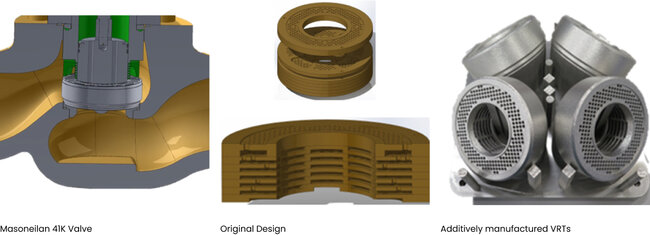
Variable Resistance Trim
Baker Hughes’ Masoneilan Innovates Variable Resistance Trim via Additive Manufacturing
The 140-year-old Masoneilan brand is famous for process industry innovations, and one such innovation is the Variable Resistance Trim or VRT. VRT is a tortuous path control valve trim used to manage high pressure, high temperature liquids. It sits inside a valve body where an actuated plug travels up and down to control the amount of flow through the stack. It is deployed where the combined pressure, temperature and velocity energy of the fluid are powerful enough to physically destroy conventional valve trim within days of operation, reducing plant uptime and profitability with it.
While there are no questions to performance of existing product, there are challenges with the complexity of manufacturing process and variety of vendors involved that often lead to long lead-times, making it tough to meet urgent customer needs. The Baker Hughes Additive Manufacturing and Valves teams collaboratively qualified manufacturing these trims via 3D-printing as a single part with a premium material and with reduced lead-time.
Existing Design
The VRT is a customized product of the twists and turns that make up the tortuous path. This is enabled by the unique construction of the VRT cage, developed more than 50 years ago. The process starts with a series of thin flat disks that are laser cut to create the flow path. When these disks are assembled into a set, the resulting flow path is a three-dimensional cavity that directs flow both radially and vertically. These engineered plates are brazed together at elevated temperature, creating a functionally solid component. This multi-disk construction offers tremendous flexibility to characterize the Flow Coefficient Cv vs Travel performance curve, as often demanded by users, by altering the plate cut-outs. This concept has been deployed in hundreds of VRT global installations, particularly successful in high temperature feedwater control applications in power generation, and pump bypass and minimum flow applications in general.
Validated Technology
The additively manufactured VRT stacks have been tested and qualified for production since 2020. This qualification allowed product customization via digital part design, offering an upgrade to a preferred Inconel 718, consolidating parts in the assembly to print as one part, and bringing most of manufacturing in-house for supply chain simplification and better control of quality. 3D-printing has enabled Masoneilan to reduce the lead time by more than half versus the legacy processes, going from 25 weeks to 6 weeks, with options for expediting because Baker Hughes owns the critical processes. More than 100 VRTs have been delivered in 21 unique designs to date.
Challenges
- Addressing urgent customer needs in short lead-time.
- High manufacturing complexity (laser cutting, brazing, and machining).
Results
- Passed thorough functional, material, and equivalency testing.
- Addressing urgent customer needs in short lead-time.
- 25+ weeks to ~6 weeks manufacturing time reduction.
- Improving reliability by eliminating brazed joints.
- Digitizing inventory.
- Reduction in production steps – safer, cleaner, and lesser waste manufacturing.
- Part consolidation 15+ brazed plates to 1 printed part with reduction in manufactured steps, which results in carbon footprint reduction and minimum waste.
- Manufacturing process control.
Benefits
- Lead-time reduction: 25+ to less than 6 weeks
- Part consolidation: 15+ parts to 1


